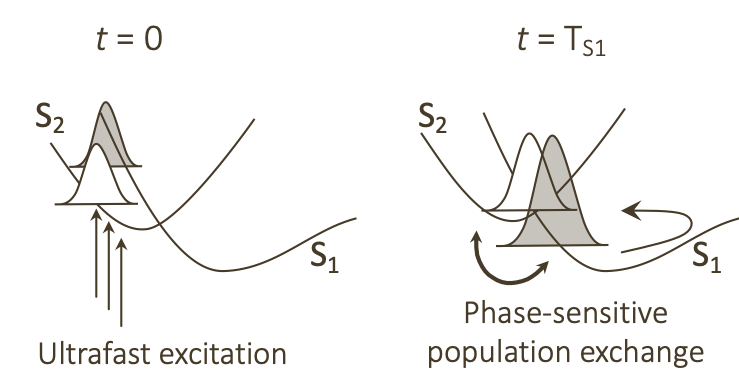Isotope effects in non-adiabatic dynamics in atto-pumped molecules
The higher the energy - the higher the density of electronic states even in the case of simple diatomic molecules. In this forest of electronic states the break-down of the Born-Oppenheimer approximation is rather a rule than an exception. Pumped by an ultrafast pulse the wave packets on coupled electronic states exchange their population. Using exact quantum dynamical simulations we show that in both adiabatic and diabatic pictures this transfer is strongly affected by the dynamical properties of the wave packets - time-dependent mean position, momentum and even time-dependent phase of the wave packets. To resolve the electron-nuclei correlation we compare the field-induced dynamics in different isotopomers of the molecules studied – conventional technique of the chemical kinetics measuring the isotope effect.
See also the lecture: Nuclear quantum effects in the non-adiabatic dynamics: simple illustration in the ultrafast pumped N2
Diabatic picture: dynamics between the bound states in isotopomers of Nitrogen molecule
Bound states: Schematic example of the diabatic transfer of the population after ultrafast coherent pumping to the valence (S1) and Rydberg (S2) electronic states. The rate and the direction of transfer is sensitive to the time-dependent phase-matching between the two wave packets and is strongly affected by mass.
Nitrogen molecule is one of the most studied cases with strongly coupled excited electronic states. Diabatic coupling is localised in the Franck-Condon region, therefore the exchange of the population between the excited states starts from the very beginning of the dynamics. We consider ultrafast excitation of two Rydberg and one valence electronic states.
Initially the wave packets on the pumped electronic states are similar and the population transfer induced by the diabatic coupling has no isotope effect. When the wave packets come back to the coupling region they overlap again and exchange their population. At this point each of the wave packets experienced different paths: started at the same Franck-Condon point they explored the potential different for each electronic state and therefore accumulated a specific phase.
We show that this pre-history of the dynamics is different for different isotopomers. The diabatic population exchange is governed by the interference patterns in the overlap between the coupled wave packets. Our computations together with an analytical toy-model establish the connection between the strong isotope effect in the diabatic transfer and evolution of the phases of the nuclear wave packets.
Full story: Time-dependent view of an isotope effect in electron-nuclear nonequilibrium dynamics with applications to N2. PNAS, 115, 5890-5895 (2018)
Non-adiabatic transfer between the dissociative states in LiH and its isotopomers
Dissociative states:
LiH potentials and non-adiabatic couplings (NAC). Three wave packets initially pumped during an ultrafast excitation probe the state of each other during the non-adiabatic transfer
Exciting molecules with a short strong few cycle IR pulse initiates non-adiabatic transfer between already populated electronic states. We explore this new feature using accurate quantal simulations of the ultrafast laser-induced dissociative dynamics in LiH-LiD-LiT series of isotopomers. In this novel type of initial state the non-adiabatic amplitude exchange between the coupled electronic states strongly depends on isotopic composition.
The effective non-adiabatic coupling strength is modulated by two counteracting factors. On one hand, the 1/mass factor makes the non-Born-Oppenheimer coupling weaker for the heavier masses. On the other hand, the transfer is modulated by the momentum coupling of the two non stationary nuclear wave packets on the two electronic states. The magnitude of this coupling tends to be larger for the heavier isotopes and varies in time as the wave packet dynamics unfold. The correlation in motion of the nuclear wave packets in R- and k-space is then critical. The direction of population transfer changes in time according to the evolution of the coherences built during the short fs excitation. In addition, heavier isotopomers move slower through the non-adiabatic interaction allowing a longer effective duration for the transfer. As a result, initially very moderate isotope effect in the immediate post excitation population rapidly grows when the wave packets transverse the non-adiabatic coupling region. We compare and contrast with similar time dependent effect of the mass in the non-adiabatic transfer in N2 where the optically accessible singlet electronic states are all bound and the couplings are quite different.
Full story: Correlated electron-nuclear motion during non-adiabatic transitions in LiH and its isotopomers. J. Phys. B: At., Mol. Opt. Phys., 2020.

